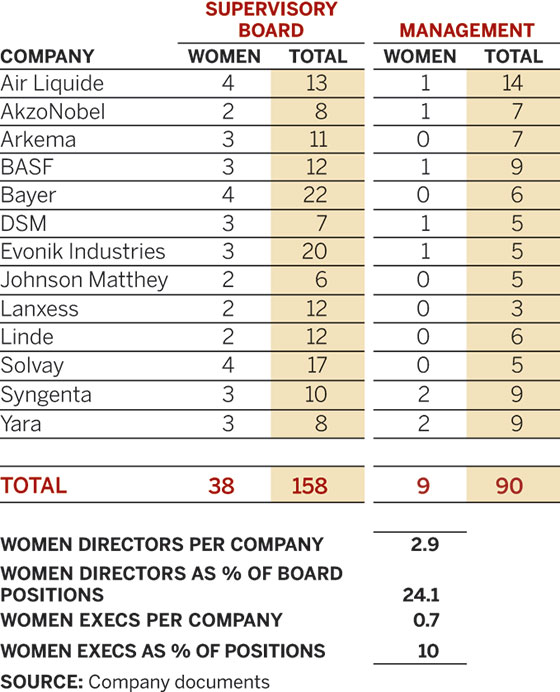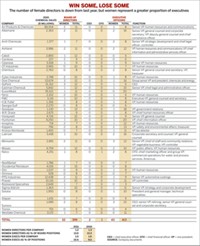Advertisement
Grab your lab coat. Let's get started
Welcome!
Welcome!
Create an account below to get 6 C&EN articles per month, receive newsletters and more - all free.
It seems this is your first time logging in online. Please enter the following information to continue.
As an ACS member you automatically get access to this site. All we need is few more details to create your reading experience.
Not you? Sign in with a different account.
Not you? Sign in with a different account.
ERROR 1
ERROR 1
ERROR 2
ERROR 2
ERROR 2
ERROR 2
ERROR 2
Password and Confirm password must match.
If you have an ACS member number, please enter it here so we can link this account to your membership. (optional)
ERROR 2
ACS values your privacy. By submitting your information, you are gaining access to C&EN and subscribing to our weekly newsletter. We use the information you provide to make your reading experience better, and we will never sell your data to third party members.
Business
Women In Industry
In the boardroom and executive suite, women's participation is still minuscule
by Alexander H. Tullo
July 30, 2007
| A version of this story appeared in
Volume 85, Issue 31

BY THE YARDSTICK used in C&EN's annual survey of women serving as key managers and as directors of publicly traded chemical companies, women have made some progress in top management. But the progress is slow, and the representation of women at the highest levels of the chemical business is still minuscule.
Of the 416 people serving on the boards of directors at the 42 chemical companies surveyed, 12.0% are women. This is better than the 11.1% of 415 directors found in the 2006 survey, although it is still below the 12.8% posted in 2003.
More women are serving as executive officers at chemical companies this year—9.2% of 404 positions included in the survey. In the 2006 survey, female representation among 413 positions surveyed was 8.7%.
Information about chemical companies' boards of directors used for the survey is culled from the most recent company annual reports and proxy statements. Executive officers are people listed as such in companies' annual 10-K filings with the Securities & Exchange Commission.
Three companies that were surveyed last year aren't included in the 2007 survey: Engelhard was purchased by BASF, Kerr-McGee spun off its titanium dioxide pigments business as Tronox, and Phelps Dodge sold its carbon black business to South Korea's DC Chemical. These three companies have been replaced by Tronox, Nalco, and Rockwood Specialties. The 2006 survey results have been revised accordingly.
No woman serves as chief executive officer or chief operating officer at a public chemical company, but three serve as chief financial officers. One is Karen R. Osar, CFO of Chemtura. Though she appears in the survey, she retired at the end of March and was replaced by Stephen C. Forsyth, formerly a vice president with Hexcel.
Appointed last October, Sallie B. Bailey is CFO of Ferro. She was formerly vice president of finance and controller at engineered bearing manufacturer Timken. Mary Mikkelson is CFO of Tronox, a position she has held since 2005.
Not every chemical company is publicly traded, and as a result, a few prominent women aren't captured by the survey. One woman is Stephanie A. Burns, who has served as CEO of the Dow Corning joint venture since January 2004. Another is Stacy Methvin, president and CEO of Shell Chemical LP, the U.S. arm of Shell Chemicals. She took over the position from another woman, Fran Keeth, who held the position from 2001 to 2006.
Sarah R. Coffin is president of Hexion Specialty Chemicals' performance products division. Though the company once planned an initial public offering, it isn't publicly traded and isn't included in the survey.
Other prominent women at private chemical companies include Peggy Viehweger, CEO of phosphorus flame-retardant maker Supresta, and Inga Carus, CEO of permanganate chemical producer Carus.
Another notable woman is Charlene T. Begley, who is stepping down as head of GE Plastics???a nonexecutive position at General Electric???now that GE is selling the business to Saudi Basic Industries Corp. She will be replaced by Brian T. Gladden under the new ownership but will stay at GE.
C&EN'S SURVEY may be the only survey that tracks the number of women at the top of U.S. chemical companies, but it is modeled on similar surveys conducted by Catalyst, a New York City-based research and advisory firm dedicated to advancing women in business. It released its "2006 Census of Women Corporate Officers, Top Earners, and Directors of the Fortune 500" in February 2007.
Catalyst's survey found that 15.6% of the 10,145 corporate officers at Fortune 500 companies in 2006 were women, a decrease from the 16.4% found in 2005. Of the 5,636 Fortune 500 directors, 14.6% were women, down slightly from the 14.7% found in 2005.
Catalyst's numbers for officers at Fortune 500 companies may seem to dwarf those found in the chemical industry. The "corporate officers" category that the group uses, however, is a broader, less well-defined category than "executive officers," and it includes many vice presidents and other lower ranked executives. The less exclusive category tends to capture more female employees.
Having more women in top management is good for business, according to Catalyst President Ilene H. Lang. Catalyst research shows that companies with the highest percentage of women corporate officers posted on average a 35.1% higher return on equity than companies with the lowest representation of women. "Companies that proactively and successfully harness all their talent will sustain significant advantages over competitors that don't," Lang said last July when Catalyst released its 2006 survey of women corporate officers.
Darlene MacKinnon, a member of Dow's global diversity and inclusion office, agrees. "What gets powerful from a competitive advantage point of view is creating the environment where those differences that people bring to the table are really utilized for advantage," she says. "That's where those different experiences and views come to life and start to make a difference in the way you approach problems, develop products, and interact with customers."
According to MacKinnon, Dow's effort to enhance diversity focuses on making the company a good place for everybody to work. In addition to the number of women represented at various tiers of management, she says, one of the metrics Dow uses to measure success is how many of its first-choice candidates for jobs accept the offer to work at Dow. "If you believe, as we do, that talent is equally distributed around the human race, then you need to make sure that you're seeking out the best talent wherever it may be," she says. "And that may take a little bit of extra work."




Join the conversation
Contact the reporter
Submit a Letter to the Editor for publication
Engage with us on Twitter